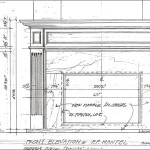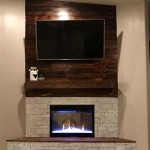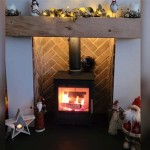Wood Burning Fireplace Smoke In House: Causes, Prevention, and Solutions
A wood-burning fireplace can be a source of warmth and ambiance during colder months. However, when smoke enters the house instead of rising up the chimney, it presents a problem that can range from a minor annoyance to a significant health hazard. Understanding the reasons behind this issue and implementing preventative and corrective measures are crucial for maintaining a safe and enjoyable home environment.
The presence of smoke inside a house with a lit fireplace indicates a disruption in the proper drafting of the chimney. A chimney draft is the upward flow of air that carries combustion byproducts, including smoke, out of the house. When this draft is compromised, the smoke can backdraft into the living space. Several factors can contribute to this problem, often working in combination.
Understanding Chimney Draft and Its Disruptions
The fundamental principle behind a functioning fireplace is the creation of a pressure differential between the inside of the house and the top of the chimney. Warm air, being less dense, rises. When a fire is lit in the fireplace, it heats the air inside the chimney. This warm air rises, creating a low-pressure area at the bottom of the chimney near the fireplace opening. The higher pressure outside the house then pushes air into the fireplace, fueling the fire and carrying the smoke upward through the chimney. Any factor that hinders this natural process can cause smoke to enter the house.
One of the most common causes of poor chimney draft is a cold chimney. A cold chimney lacks the buoyant force needed to initiate the upward flow of air. Especially in houses located in colder climates, the masonry of the chimney can become significantly chilled, particularly if the fireplace has not been used for an extended period. This cold air within the chimney is denser than the warm air from the fire, effectively blocking the upward draft. Establishing a warm draft is a necessary preliminary step before lighting a substantial fire.
Another significant contributor to backdrafting is negative air pressure within the house. Modern homes are often built with tighter seals to improve energy efficiency. This can inadvertently create a situation where exhaust fans, clothes dryers, or even a tightly sealed house combined with a strong outdoor wind can lower the air pressure inside the house below the pressure outside. This pressure imbalance can overcome the natural draft of the chimney, causing smoke to be drawn into the house instead of drawn up the chimney.
Obstructions within the chimney flue can also severely impede the draft. These obstructions can range from bird nests and animal debris to creosote buildup. Creosote is a byproduct of incomplete combustion of wood and accumulates on the inner walls of the chimney. Over time, thick layers of creosote can constrict the airflow and even pose a significant fire hazard. Regular chimney inspections and cleaning are essential to prevent creosote buildup and remove any other obstructions that may be present.
Furthermore, the design and construction of the chimney itself can affect its drafting performance. An improperly sized chimney flue can either be too small, restricting airflow, or too large, allowing the smoke to cool and descend before it reaches the top. The height of the chimney above the roof is also critical. Building codes often specify minimum chimney heights to ensure that the chimney extends above the roofline and surrounding obstructions, such as trees or nearby buildings. Insufficient chimney height can lead to downdrafts, where wind forces the smoke back down the chimney.
Prevention Strategies to Minimize Smoke Entry
Preventing wood-burning fireplace smoke from entering the house involves a multi-faceted approach that considers the factors discussed above. Addressing the issue of a cold chimney is often the first step. This can be accomplished by using a small piece of rolled newspaper or kindling to start a small fire at the top of the fireplace opening. This "priming" fire warms the air within the chimney and establishes a positive draft before a larger fire is built. A propane torch can also be used carefully to warm the air inside the flue.
To counteract negative air pressure within the house, consider slightly opening a window near the fireplace before lighting a fire. This allows outside air to enter the house, equalizing the pressure and reducing the likelihood of backdrafting. It is also advisable to minimize the use of exhaust fans and other appliances that draw air out of the house while the fireplace is in use.
Regular chimney inspections and cleaning are paramount to preventing smoke problems. A qualified chimney sweep can inspect the chimney for obstructions, creosote buildup, and structural damage. Professional cleaning removes creosote and other debris, ensuring optimal airflow and reducing the risk of chimney fires. The National Fire Protection Association (NFPA) recommends that chimneys be inspected annually and cleaned as needed.
Another preventative measure involves using seasoned firewood. Seasoned firewood has been dried for at least six months to a year, reducing its moisture content. Burning dry wood produces less smoke and creosote compared to burning green or wet wood. This not only reduces the amount of smoke entering the house but also minimizes creosote buildup in the chimney. It is crucial to store firewood in a dry, well-ventilated area to promote proper seasoning.
The design of the fireplace itself can also influence the amount of smoke produced. Fireplaces with glass doors can help to contain smoke and improve efficiency. When the doors are closed, the fire burns more efficiently, producing less smoke. Fireplace inserts, which are essentially enclosed stoves that fit inside an existing fireplace, offer even greater efficiency and smoke reduction.
Corrective Actions and Solutions for Smoke Problems
When smoke is already entering the house from the fireplace, several corrective actions can be taken. The initial step is to extinguish the fire safely. This can be achieved by using a fire extinguisher or by carefully smothering the fire with sand or dirt. Avoid using water, as it can create a dangerous steam explosion within the fireplace and chimney. Once the fire is extinguished, investigate the potential causes of the smoke problem.
If a cold chimney is suspected, repeat the priming fire process. Start a small fire at the top of the fireplace opening to warm the chimney flue. Monitor the draft to ensure that the smoke is rising up the chimney before attempting to light a larger fire.
If negative air pressure is the likely cause, open a window near the fireplace or temporarily turn off exhaust fans and other appliances that draw air out of the house. Observe whether this action improves the draft and reduces the amount of smoke entering the house.
If obstructions are suspected, a professional chimney sweep should be contacted to inspect and clean the chimney. Do not attempt to remove obstructions yourself, as this can be dangerous and may damage the chimney. A chimney sweep has the necessary tools and expertise to safely and effectively remove obstructions and ensure that the chimney is in good working order.
In some cases, structural issues with the chimney may be contributing to the problem. Cracks, leaks, or an improperly sized flue can all affect the draft. A qualified mason or chimney repair specialist can assess the chimney and recommend necessary repairs or modifications. This may involve relining the chimney flue, repairing cracks, or adjusting the height of the chimney.
For persistent smoke problems, consider installing a chimney cap with a built-in draft inducer. A draft inducer is a fan that is installed at the top of the chimney to enhance the upward flow of air. This can be particularly helpful in situations where the chimney is shorter than recommended or is located in an area with strong winds. A draft inducer can significantly improve the drafting performance of the chimney and reduce the likelihood of smoke entering the house.
Another solution is to consider alternative heating options. If the fireplace is consistently causing smoke problems despite various preventative and corrective measures, it may be prudent to explore other heating sources, such as gas fireplaces, electric fireplaces, or central heating systems. These options offer greater convenience and control, and they eliminate the risk of smoke entering the house.
The installation of carbon monoxide detectors is essential in any home with a wood-burning fireplace. Carbon monoxide is a colorless, odorless gas that is produced by incomplete combustion. It can be deadly if inhaled in high concentrations. Carbon monoxide detectors provide an early warning of dangerous levels of carbon monoxide in the house, allowing occupants to evacuate safely.

Fireplace Smoke In House What To Do

This Might Be Why Your Fireplace Is Smoking Up The House Bob Vila

Common Causes Of Smoke From The Fireplace Backing Up Into Your Home

Why Does My Fireplace Smoke Up House Puroclean Hq

Why Your Fireplace Is Smoking How To Fix A Smokey

Why Does My Fireplace Smoke

Smokey House Due To Chimney Fire In Baltimore Chimneytek

Fireplace Smokes On Windy Days Chimneys Com

Can Fireplace Smoke Be Harmful To Your Health We Love Fire

Dealing With Fireplace Smoke In House Causes And Solutions
Related Posts








